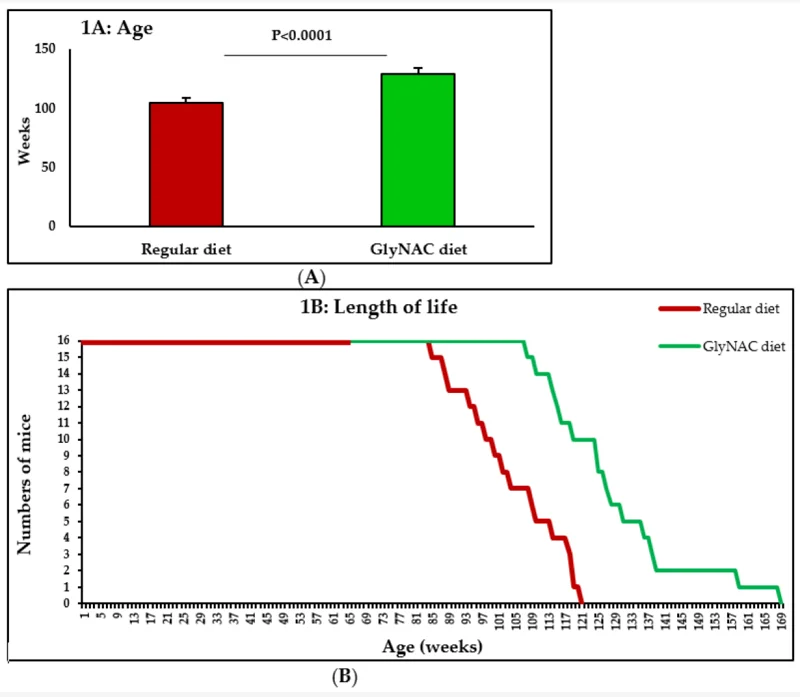In a study conducted by scientists from Baylor College of Medicine in Houston, supplementation of glutathione had a drastic effect on the lifespan of wild-type mice, both male and female [1].
Dangerous species
Oxidative stress happens when the delicate balance between the production and degradation of reactive oxygen species (ROS) is lost. This can be caused by various stressors, such as UV radiation, but also by aging.
ROS are byproducts of normal oxygen metabolism, which, like many chemical processes, is indispensable for life but also produces toxic waste (although ROS also plays some beneficial roles) [2]. The body has robust anti-ROS protections in place, which is why ROS levels in cells are low and stable in youth. Alas, all our defense mechanisms slowly decay with time, which can be considered the essence of aging.
ROS accumulation is not considered a hallmark of aging, but it deeply affects other hallmarks, such as mitochondrial dysfunction and genomic instability, because accumulated ROS interfere with chemical processes all over the body.
Glutathione (GSH) is the most abundant intracellular antioxidant, the backbone of natural defenses against ROS. It is a tripeptide composed of glycine, cysteine, and glutamic acid. GSH levels decline with age, so supplementing it could plausibly affect other processes of aging.
This can be achieved with GlyNAC, a combination of two GSH precursors, glycine and N-acetylcystein. GlyNAC has already been an object of several studies. The same group that is behind this new paper has previously shown that continuous GlyNAC supplementation alleviates mitochondrial dysfunction and improves mitophagy (degradation of dysfunctional mitochondria), nutrient sensing, and genome stability in humans [3]. It also reverses premature aging in people with HIV [4].
Why would the group move from human to mouse trials? As the authors explain, humans are so long-lived that it makes studying any intervention’s direct effect on lifespan virtually impossible. To be able to do this, you need species with a much shorter lifespan, such as mice.
Best-in-class results
The researchers ran two studies simultaneously, one dedicated solely to determining the effect of GlyNAC on lifespan and the second one on various other parameters. Importantly, the scientists used wild-type mice, rather than mice genetically engineered for accelerated aging. The 32 mice in this study were equally divided between the study group and the control group. At the age of 65 weeks, which is mid-life by mouse standards, 8 males and 8 females started receiving GlyNAC with food. Supplementation continued until the mice died of age-related diseases. This study is slightly larger than other influential “proof of concept” studies, which are typically conducted on about a dozen mice.
Mice on GlyNAC lived, on average, 24% longer than the controls: 129 vs. 104 weeks. This rivals some of the best life extension results ever achieved in mice. Importantly, the effect was equally strong in males and females, contrary to some other promising geroprotective compounds that are sex-specific. The graph shows an unmistakable shift in the survival curve:

Bring them all back!
The second study analyzed the effect of GlyNAC supplementation on GSH levels, oxidative stress, mitochondrial dysfunction, mitophagy, nutrient sensing, and genomic damage in the hearts, livers, and kidneys of old mice.
First, it found what we already knew: GSH concentration in the old animals was 65% to 72% lower. GlyNAC supplementation was able to bring GSH levels back to normal. GSH synthesis, substantially slowed by age, also bounced back as a result of GlyNAC supplementation.
Levels of TBARS, an oxidative stress marker, were around twice as high in old untreated mice than young mice. Here again, GlyNAC did wonders, bringing TBARS back to almost youthful levels.
In all the other key areas, mitochondrial function, mitophagy, nutrient sensing (measured by SIRT3 levels), and genomic stability (measured by phosphorylated histone protein H2AX), the results were equally impressive: the markers bounced back almost to the levels observed in young mice. Such wall-to-wall positive results are rarely seen in a study.
Conclusion
This study might put glutathione on the list of the most promising life-extending molecules. GSH is known to be safe and is already marketed as a supplement, although more research is needed to confirm its efficacy in humans. The results of this study probably warrant GSH inclusion in the ITP program, which tests various potentially life-prolonging compounds in mice in three different institutions, providing an especially robust testing environment. It would also be interesting to see the results of combining GlyNAC with other known life-prolonging interventions such as caloric restriction.
Literature
[1] Kumar, P., Osahon, O. W., & Sekhar, R. V. (2022). GlyNAC (Glycine and N-Acetylcysteine) Supplementation in Mice Increases Length of Life by Correcting Glutathione Deficiency, Oxidative Stress, Mitochondrial Dysfunction, Abnormalities in Mitophagy and Nutrient Sensing, and Genomic Damage. Nutrients, 14(5), 1114.
[2] Santos, A. L., Sinha, S., & Lindner, A. B. (2018). The good, the bad, and the ugly of ROS: new insights on aging and aging-related diseases from eukaryotic and prokaryotic model organisms. Oxidative medicine and cellular longevity, 2018.
[3] Kumar, P., Liu, C., Hsu, J. W., Chacko, S., Minard, C., Jahoor, F., & Sekhar, R. V. (2021). Glycine and N-acetylcysteine (GlyNAC) supplementation in older adults improves glutathione deficiency, oxidative stress, mitochondrial dysfunction, inflammation, insulin resistance, endothelial dysfunction, genotoxicity, muscle strength, and cognition: Results of a pilot clinical trial. Clinical and translational medicine, 11(3), e372.
[4] Kumar, P., Liu, C., Suliburk, J. W., Minard, C. G., Muthupillai, R., Chacko, S., … & Sekhar, R. V. (2020). Supplementing glycine and N-acetylcysteine (GlyNAC) in aging HIV patients improves oxidative stress, mitochondrial dysfunction, inflammation, endothelial dysfunction, insulin resistance, genotoxicity, strength, and cognition: results of an open-label clinical trial. Biomedicines, 8(10), 390.





